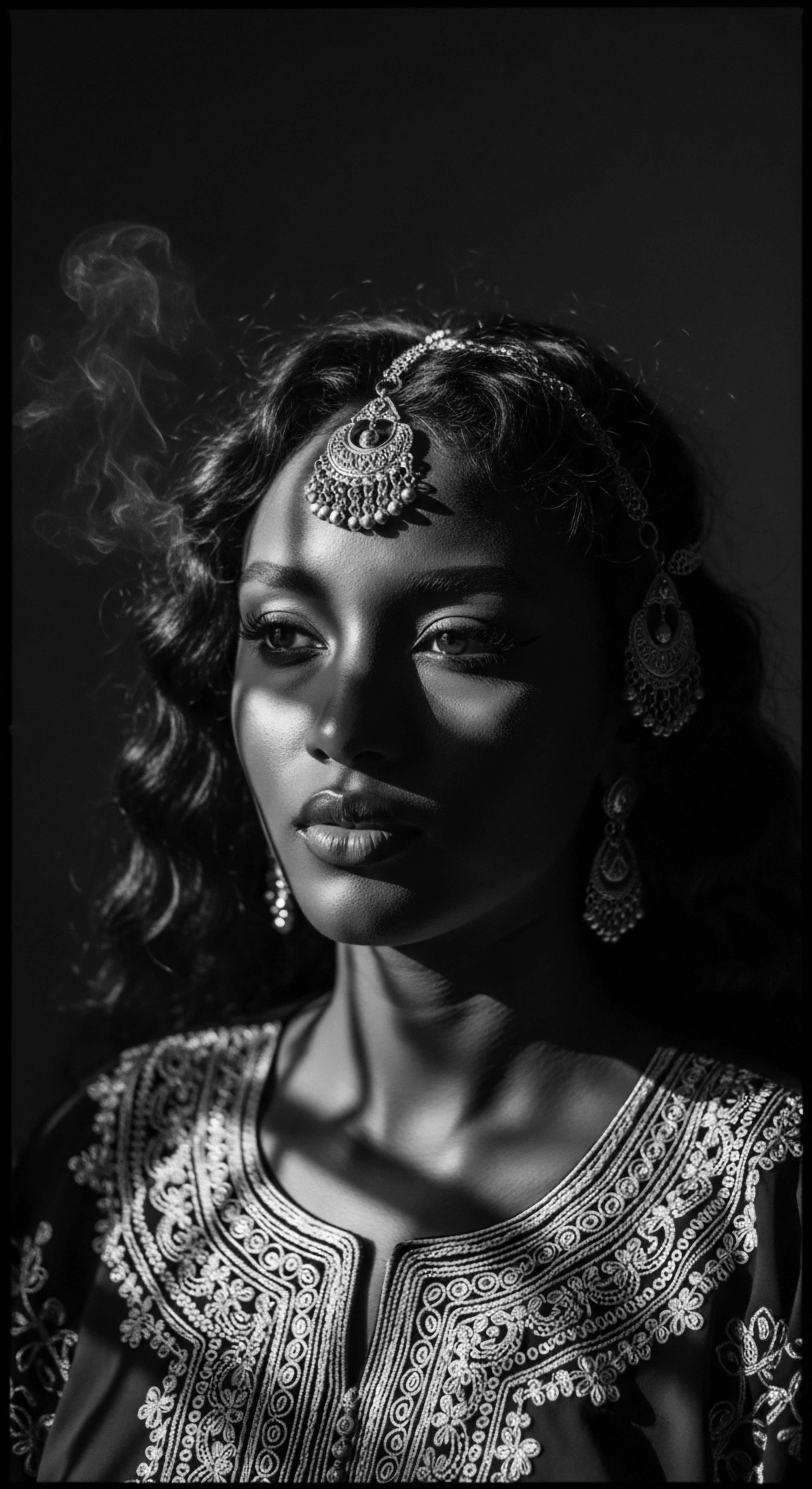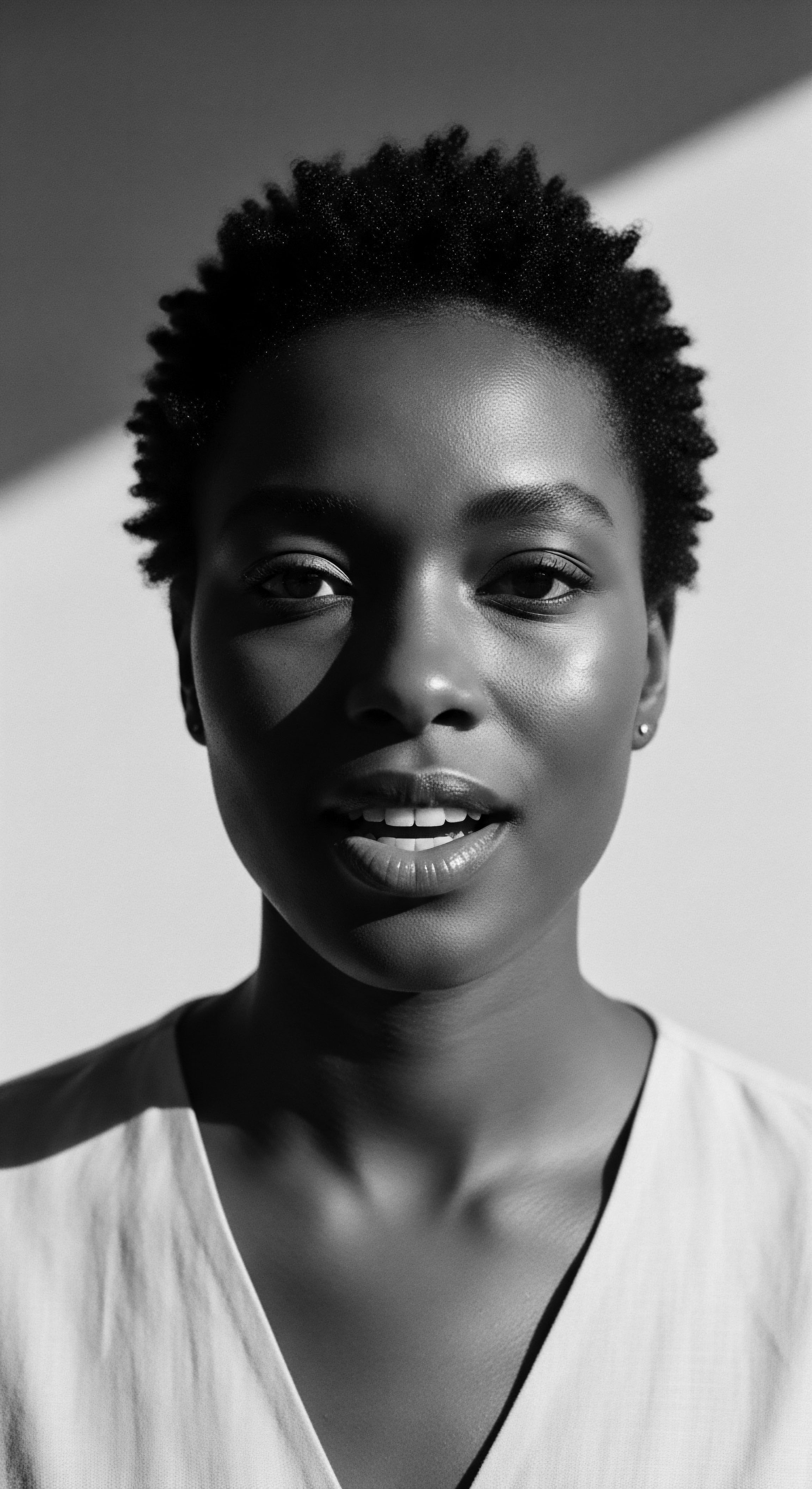
Roots
To journey into the historical significance of nighttime hair coverings for textured hair is to listen to the whispers of generations, a dialogue echoing from ancient lands to modern hearths. It is not a tale confined to fleeting trends or mere convenience; rather, it speaks to the very soul of a strand, tracing a lineage of care, resilience, and profound identity. For those whose hair coils and kinks in luminous patterns, protecting one’s crown during slumber became a ritual steeped in necessity and reverence, a practice woven into the fabric of daily life and ancestral wisdom.
It became an unspoken pact with oneself, a testament to the enduring beauty and inherent vulnerability of textured hair, especially against the rigors of existence. This enduring practice, while seemingly simple, carries weight, holding stories of a people and their unwavering connection to selfhood through their unique physical attributes.

The Ancestral Strand A Biological Imperative
Consider the intrinsic nature of textured hair. Its spiraling helix, unlike straighter forms, presents a greater surface area, making it naturally prone to moisture loss. Each twist and turn, while contributing to its magnificent volume and strength, also creates points of potential friction. When hair rubs against coarse surfaces, such as typical cotton pillowcases, the delicate cuticle layers can lift and abrade, leading to dryness, tangles, and breakage.
This elemental biology, a reality for textured hair across millennia, made intentional protection a practical imperative. Long before scientific explanations articulated the specifics of cuticle health or moisture retention, ancestral communities understood the tangible benefits of safeguarding their hair.
In pre-colonial Africa, hair was far more than an adornment; it served as a living canvas, communicating social status, age, marital standing, and even tribal affiliation. Hairstyles, often intricate and time-consuming to create, were symbols of health and prosperity, sometimes even used to send messages to the gods. (Johnson & Bankhead, 2014) The careful construction of these elaborate styles meant their preservation was paramount. While daytime headwraps served distinct ceremonial and social purposes, the nighttime protection often employed simpler, utilitarian coverings.
These coverings, whether woven from natural fibers or crafted from animal hides, would have provided a barrier against environmental elements and the mechanical stress of sleep, ensuring the longevity of meticulously styled hair. This foresight, rooted in a deep, experiential understanding of hair’s needs, shaped early protective practices, laying the groundwork for traditions that would travel across oceans and survive epochs.
The practice of covering textured hair at night is a deeply rooted tradition, born from the inherent biology of coiled strands and sustained by generations who recognized its vital role in preserving both hair health and cultural integrity.

Ancient Echoes of Care Did Nighttime Coverings Exist?
While direct archaeological evidence of specific nighttime hair coverings from ancient African civilizations might be rare, the prevailing cultural practices surrounding hair suggest a strong likelihood of such habits. In ancient Egypt, for instance, elaborate wigs and extensions were common, often adorned with precious metals and jewels. The preservation of these complex coiffures, indicative of status and beauty, would have necessitated protection during rest.
Likewise, across diverse African societies, from the Yoruba with their spiritual reverence for hair to the Mblanta people of Namibia known for their incredibly long braided styles, hair was a central component of identity and ritual. (Chimbiri, 2021) The very time and skill invested in these styles suggest a corresponding effort to maintain them, and a night without protection would have undone hours of careful work.
- Yoruba Headwraps ❉ Used for various purposes, including indicating marital status, wealth, and spiritual adherence, sometimes influencing daytime and nighttime practices for preservation.
- Nubian Hair Practices ❉ Evidenced through ancient artifacts showing intricate braids and adornments, implying a need for careful upkeep and protection.
- West African Braiding ❉ Often intricate and symbolic, demanding protection to prolong style integrity and prevent friction-induced damage.
The materials used for these early coverings would have been those readily available ❉ soft cloths made from indigenous fibers, possibly treated with natural oils to reduce friction. This communal knowledge, passed down through matriarchal lines, underscored the understanding that hair was not merely an aesthetic feature but a living part of one’s being, deserving of continuous, gentle care. The very act of covering hair at night became a quiet, personal ritual, connecting individuals to a collective wisdom that valued holistic well-being and the careful guardianship of one’s physical and spiritual crown.

Ritual
The ritual of covering textured hair at night transcends simple hygiene; it represents a profound act of self-preservation and cultural continuity. As African people were forcibly taken across the Atlantic, carrying with them fragments of their heritage, the practice of hair covering adapted to new, often brutal, realities. What began as a traditional method of protection and adornment transformed into a symbol of both oppression and defiant resistance, a testament to the indomitable spirit of those who sought to hold onto their identity amidst profound dehumanization.

From Utility to Resistance The Enslaved Experience
During the era of transatlantic slavery, head coverings, while sometimes provided by enslavers for utilitarian purposes—to protect hair from harsh labor conditions, dust, and lice—took on a far darker, more insidious meaning. Laws were enacted in some colonial territories to strip enslaved and even free Black women of their dignity, forcing them to wear simple kerchiefs or tignons as outward markers of their subordinate status. The Tignon Laws , passed in Louisiana in 1786, are a stark example, requiring free Black women to wear headwraps (tignons) to distinguish them from white women and supposedly diminish their allure to white men. Yet, in an astonishing act of defiance, these women reclaimed the tignon, styling them with such artistry and using luxurious fabrics that what was intended as a symbol of subjugation became a statement of their inherent beauty, wealth, and cultural pride.
This transformation from an imposed symbol of inferiority to an emblem of resistance speaks volumes about the deep spiritual and cultural connection Black women held with their hair. Unable to perform elaborate styling rituals that were central to their ancestral communities, due to lack of time, resources, and the oppressive environment, the headwrap became a critical tool. It protected delicate strands from damage during long hours of labor, preserved what little moisture their hair retained, and perhaps most crucially, allowed them to maintain a semblance of personal dignity and connection to their heritage in a world designed to strip them of both. The nightly act of wrapping one’s hair, even in the simplest cloth, became a private ceremony, a small yet significant act of self-care against a backdrop of immense adversity.
Nighttime hair coverings, especially within the context of transatlantic slavery, evolved from a forced symbol of oppression to a powerful emblem of resistance and cultural reclamation for Black women.

The Bonnet’s Modern Ancestry A Symbol Endures
As the centuries turned, and particularly into the 20th century, the hair bonnet, often made of silk or satin, emerged as a widely adopted nighttime hair covering for Black women, a direct descendant of those earlier protective practices. While the term “bonnet” has European origins and was once a common accessory across various cultures, its specific use and significance within the Black community shifted to prioritize hair health and the preservation of styles. The natural hair movement, gaining prominence in the 1960s and 70s, and experiencing a resurgence in recent decades, further solidified the bonnet’s status.
| Era/Context Pre-Colonial Africa |
| Primary Purpose Style preservation, status, spiritual connection, environmental protection |
| Materials/Forms Woven fibers, animal hides, possibly early forms of tied cloths |
| Era/Context Slavery/Colonial Era |
| Primary Purpose Forced subservience (by oppressors); Resistance, dignity, hair protection (by enslaved) |
| Materials/Forms Rough cotton rags, handkerchiefs; later reclaimed with luxurious fabrics for defiance |
| Era/Context Early 20th Century to Present |
| Primary Purpose Moisture retention, friction reduction, style preservation, cultural pride |
| Materials/Forms Silk, satin bonnets, scarves, pillowcases |
| Era/Context This progression reveals a persistent thread of hair protection, continually adapting and symbolizing deep heritage and resilience. |
The scientific understanding that emerged centuries later provided a clearer rationale for these long-standing practices. The smooth surface of silk and satin minimizes friction against the hair shaft, reducing tangles, breakage, and frizz. These materials also absorb less moisture than cotton, allowing textured hair, which tends to be drier, to retain its natural oils and applied products overnight.
Thus, the seemingly simple act of donning a bonnet before sleep is a continuation of an ancestral wisdom, now validated by modern science. It connects contemporary Black women to a lineage of care that adapted, survived, and ultimately thrived in the face of immense challenges, making the bonnet not just a hair accessory, but a living piece of cultural heritage.

Relay
The enduring practice of nighttime hair coverings for textured hair, a practice deeply rooted in the soil of heritage, serves as a powerful relay of cultural knowledge, scientific understanding, and communal identity across generations. This ritual, far from being static, has continuously adapted, reflecting the evolving socio-cultural landscapes while steadfastly affirming the intrinsic value of textured hair. It is a dialogue between past wisdom and present innovation, where each thread of silk or satin carries the weight of history and the promise of future health.

What Historical Accounts Reveal About Protective Nighttime Practices?
Historical accounts, though sometimes sparse in explicit detail regarding specific nighttime regimens, consistently highlight the reverence for hair across African societies and the lengths to which individuals went to preserve their elaborate hairstyles. In many African tribal cultures, hair was meticulously styled over days, adorned with clay, butter, or precious beads, and imbued with spiritual significance. The very investment of time and resources in these styles necessitated a means of protection, and the practicality of coverings during rest would have been self-evident. While direct mentions of “bonnets” in ancient texts are scarce, the widespread use of headwraps for various social, spiritual, and protective purposes throughout African history strongly suggests an inherent understanding of covering hair for preservation, including overnight.
The experience of enslaved African women in the Americas, however, offers a particularly poignant historical case study of nighttime hair coverings. Stripped of their traditional tools and communal styling rituals, these women repurposed available materials – scraps of fabric, handkerchiefs, or even coarse cotton – to protect their hair from the harsh realities of their daily existence and the damage incurred during sleep. (Byrd & Tharps, 2014) The fact that these coverings persisted, even as they were weaponized by colonial laws like Louisiana’s Tignon Laws to visibly mark Black women as subordinate, speaks to their absolute necessity. Women found ways to infuse these required coverings with individual style and defiance, transforming a badge of oppression into a quiet, yet potent, act of self-assertion.
This practice, though born of duress, became a vital conduit for preserving cultural memory and a deep, enduring connection to ancestral practices of hair care. The nighttime wrap offered a moment of respite and a private declaration of self-worth against overwhelming odds.

How Does Modern Science Align with Ancestral Care?
The scientific understanding of hair, particularly textured hair, has advanced considerably, yet it often serves to validate the intuitive wisdom of ancestral care practices. The coiled structure of textured hair means its cuticle, the outermost protective layer, is more susceptible to lifting and abrasion than straighter hair types. This structural characteristic makes it inherently more vulnerable to friction-induced damage. When hair rubs against typical cotton bedding, the absorbent fibers not only cause mechanical stress, leading to breakage and split ends, but also draw away essential moisture and natural oils from the hair shaft.
This is where the wisdom of silk and satin bonnets, or pillowcases, aligns perfectly with modern scientific understanding. These materials possess a smooth, tightly woven surface that significantly reduces friction, allowing hair to glide without snagging. This minimizes mechanical stress, thereby preventing breakage and preserving the integrity of the hair’s structure. Furthermore, silk and satin are non-absorbent, ensuring that the hair retains its vital moisture and any applied oils or leave-in conditioners overnight.
This retention of hydration is crucial for maintaining elasticity, preventing dryness, and reducing frizz, all common challenges for textured hair. What our ancestors practiced out of experiential knowledge and necessity, modern trichology confirms through empirical observation and material science.
- Low Friction Surfaces ❉ Silk and satin materials create minimal abrasion, safeguarding the hair’s cuticle.
- Moisture Preservation ❉ Unlike cotton, these non-absorbent fabrics ensure hair retains its natural oils and hydration.
- Style Integrity ❉ Protective coverings help maintain intricate styles, reducing the need for daily manipulation.
The legacy of nighttime hair coverings is thus a powerful illustration of continuity. It stands as a testament to the ingenuity of Black women who, through centuries of adversity, adapted and sustained practices that were not only practical for hair health but also deeply symbolic of their identity and heritage. From the ceremonial headwraps of ancient Africa to the defiant tignons of the enslaved, and now to the satin bonnets of contemporary care, the act of covering hair at night represents a profound journey of self-preservation, cultural pride, and an unbreakable link to ancestral wisdom.

Reflection
The journey through the historical significance of nighttime hair coverings for textured hair brings us to a quiet space of reflection, where the echoes of ancient wisdom meet the hum of contemporary self-care. This is not merely a practice of protective styling; it is a profound testament to an enduring heritage, a living archive inscribed upon every coil and wave. The story of covering one’s hair at night is a story of resilience, ingenuity, and an unwavering connection to identity, a quiet declaration of self-worth woven into the very fabric of daily ritual.
From the foundational biology that necessitated protection against the elements and daily friction, to the forced adaptations and radical reclamations during periods of profound oppression, the act of covering hair at night has consistently spoken volumes. It reveals how a simple piece of cloth, whether a utilitarian wrap or a meticulously chosen satin bonnet, can transcend its material form to become a vessel of ancestral knowledge and a symbol of collective strength. This heritage reminds us that self-care, particularly for textured hair, is not a modern invention but a continuation of deeply rooted practices that safeguarded physical well-being alongside spiritual and cultural identity.
The modern embrace of nighttime hair coverings, supported by scientific understanding of friction and moisture retention, serves as a powerful bridge. It connects individuals today to the silent fortitude of their forebears, allowing them to participate in a legacy of care that was fiercely protected and creatively adapted through centuries. Each time a bonnet is donned, a scarf carefully tied, it is an acknowledgment of that profound history, a gentle nod to the ‘Soul of a Strand’ that carries the stories of survival, beauty, and unwavering pride. This ritual, so personal and yet so universal within the textured hair community, is a quiet, powerful affirmation of heritage, sustaining not only the health of the hair but also the spirit of a people.

References
- Byrd, A. D. & Tharps, L. L. (2014). Hair Story ❉ Untangling the Roots of Black Hair in America (2nd ed.). St Martin’s Press.
- Chimbiri, K. N. (2021). The Story of Afro Hair ❉ 5000 Years of History, Fashion and Styles. Scholastic.
- Johnson, T. & Bankhead, T. (2014). Hair It Is ❉ Examining the Experiences of Black Women with Natural Hair. Open Journal of Social Sciences, 2(1), 86-100.
- Jacobs-Huey, L. (2006). From the Kitchen to the Parlor ❉ Language and Becoming in African American Women’s Hair Care. Oxford University Press.
- Banks, I. (2000). Hair Matters ❉ Beauty, Power, and Black Women’s Consciousness. New York University Press.
